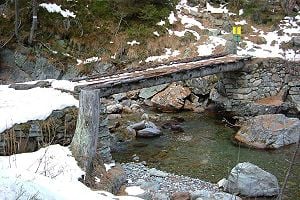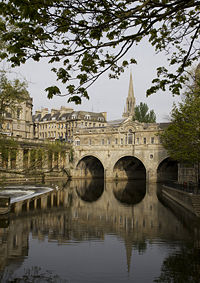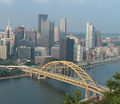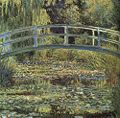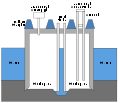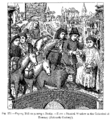Difference between revisions of "Bridge" - New World Encyclopedia
| Line 54: | Line 54: | ||
==Efficiency== | ==Efficiency== | ||
| − | A bridge's ''structural efficiency'' may be considered to be the ratio of load carried to bridge weight, given a specific set of material types. In one common challenge students are divided into groups and given a quantity of wood sticks, a distance to span, and glue, and then asked to construct a bridge that will be tested to destruction by the progressive addition of load at the center of the span. The bridge taking the greatest load is by this test the most ''structurally efficient''. A more refined measure for this exercise is to weigh the completed bridge rather than measure against a fixed quantity of materials provided and determine the multiple of this weight that the bridge can carry, a test that emphasizes economy of materials and efficient glue joints | + | A bridge's ''structural efficiency'' may be considered to be the ratio of load carried to bridge weight, given a specific set of material types. In one common challenge, students are divided into groups and given a quantity of wood sticks, a distance to span, and glue, and then asked to construct a bridge that will be tested to destruction by the progressive addition of load at the center of the span. The bridge taking the greatest load is by this test the most ''structurally efficient''. A more refined measure for this exercise is to weigh the completed bridge rather than measure against a fixed quantity of materials provided and determine the multiple of this weight that the bridge can carry, a test that emphasizes economy of materials and efficient glue joints. |
A bridge's ''economic efficiency'' will be site and traffic dependent, the ratio of savings by having a bridge (instead of, for example, a ferry, or a longer road route) compared to its cost. The lifetime cost is composed of materials, labor, machinery, engineering, cost of money, insurance, maintenance, refurbishment, and ultimately, demolition and associated disposal, recycling, and replacement, less the value of scrap and reuse of components. Bridges employing only compression are relatively inefficient structurally, but may be highly cost efficient where suitable materials are available near the site and the cost of labor is low. For medium spans, trusses or box beams are usually most economical, while in some cases, the appearance of the bridge may be more important than its cost efficiency. The longest spans usually require suspension bridges. | A bridge's ''economic efficiency'' will be site and traffic dependent, the ratio of savings by having a bridge (instead of, for example, a ferry, or a longer road route) compared to its cost. The lifetime cost is composed of materials, labor, machinery, engineering, cost of money, insurance, maintenance, refurbishment, and ultimately, demolition and associated disposal, recycling, and replacement, less the value of scrap and reuse of components. Bridges employing only compression are relatively inefficient structurally, but may be highly cost efficient where suitable materials are available near the site and the cost of labor is low. For medium spans, trusses or box beams are usually most economical, while in some cases, the appearance of the bridge may be more important than its cost efficiency. The longest spans usually require suspension bridges. | ||
| Line 71: | Line 71: | ||
<!--Image:NoImageYetRectFramed.png|<center>[[Bowstring arch]]</center>—> | <!--Image:NoImageYetRectFramed.png|<center>[[Bowstring arch]]</center>—> | ||
Image:Saltashrab.jpg|<center>[[Royal Albert Bridge|Brunel Truss bridge or lenticular truss]]</center> | Image:Saltashrab.jpg|<center>[[Royal Albert Bridge|Brunel Truss bridge or lenticular truss]]</center> | ||
| − | Image:Concrete box girder bridge.JPG|<center>[[Box girder bridge]]</center> | + | <!--Image:Concrete box girder bridge.JPG|<center>[[Box girder bridge]]</center> Creative Commons 1.0—> |
| − | Image:ThreeTwrBrCenter.jpg|<center>[[Cable-stayed bridge]]</center> | + | <!--Image:ThreeTwrBrCenter.jpg|<center>[[Cable-stayed bridge]]</center> Creative Commons 1.0—> |
Image:ForthBridgeEdinburgh.jpg|<center>[[Cantilever bridge]]</center> | Image:ForthBridgeEdinburgh.jpg|<center>[[Cantilever bridge]]</center> | ||
Image:Puente del Alamillo.jpg|<center>[[Cantilever spar cable-stayed bridge]]</center> | Image:Puente del Alamillo.jpg|<center>[[Cantilever spar cable-stayed bridge]]</center> | ||
| Line 84: | Line 84: | ||
Image:BNSFBridgeClip.jpg|<center>[[Lift bridge]]</center> | Image:BNSFBridgeClip.jpg|<center>[[Lift bridge]]</center> | ||
Image:Vallorcine footpath bridge 2003-12-13.jpg|<center>[[Log bridge]]</center> | Image:Vallorcine footpath bridge 2003-12-13.jpg|<center>[[Log bridge]]</center> | ||
| − | Image:PlateGirderUnderTracks.jpg|<center>[[Plate girder bridge]]</center> | + | <!--Image:PlateGirderUnderTracks.jpg|<center>[[Plate girder bridge]]</center> Creative Commons 1.0—> |
| − | Image: | + | Image:Pontoon bridge Rhine River 1945.jpg|<center>[[Pontoon bridge]]</center> |
Image:Uppsala Ultunabron02 2005-06-16.jpg|<center>[[Retractable bridge]]<br/>(Thrust bridge)</center> | Image:Uppsala Ultunabron02 2005-06-16.jpg|<center>[[Retractable bridge]]<br/>(Thrust bridge)</center> | ||
Image:SegmentalBridgeFtLauderdale.jpg|<center>[[Segmental bridge]]</center> | Image:SegmentalBridgeFtLauderdale.jpg|<center>[[Segmental bridge]]</center> | ||
Image:ProposedSFOBBEasternSpan.jpg|<center>[[Self-anchored suspension bridge]]</center> | Image:ProposedSFOBBEasternSpan.jpg|<center>[[Self-anchored suspension bridge]]</center> | ||
| − | Image:WinnepegBridge.jpg|<center>[[Side-spar cable-stayed bridge]]</center> | + | <!--Image:WinnepegBridge.jpg|<center>[[Side-spar cable-stayed bridge]]</center> Creative Commons 1.0—> |
| − | Image:CapilanoBridge.jpg|<center>[[Simple suspension bridge]]</center> | + | <!--Image:CapilanoBridge.jpg|<center>[[Simple suspension bridge]]</center> Creative Commons 1.0—> |
| − | Image:StepStoneBridge.jpg|<center>[[Step-stone bridge]]</center> | + | <!--Image:StepStoneBridge.jpg|<center>[[Step-stone bridge]]</center> Creative Commons 1.0—> |
Image:Holzbrücke bei Essing 1.jpg|<center>[[Stressed ribbon bridge]]</center> | Image:Holzbrücke bei Essing 1.jpg|<center>[[Stressed ribbon bridge]]</center> | ||
| − | Image:BridgeSubmerging4.jpg|<center>[[Submersible bridge]]</center> | + | <!--Image:BridgeSubmerging4.jpg|<center>[[Submersible bridge]]</center> Creative Commons 1.0—> |
Image:suspension.bridge.bristol.arp.750pix.jpg|<center>[[Suspension bridge]]</center> | Image:suspension.bridge.bristol.arp.750pix.jpg|<center>[[Suspension bridge]]</center> | ||
Image:Railway swing bridge.jpg|<center>[[Swing bridge]]</center> | Image:Railway swing bridge.jpg|<center>[[Swing bridge]]</center> | ||
| Line 100: | Line 100: | ||
Image:Millenium_bridge_close.jpg|<center>[[Tilt bridge]]</center> | Image:Millenium_bridge_close.jpg|<center>[[Tilt bridge]]</center> | ||
Image:Newport.transporter.750pix.jpg|<center>[[Transporter bridge]]</center> | Image:Newport.transporter.750pix.jpg|<center>[[Transporter bridge]]</center> | ||
| − | Image:AlhambraTrestle.jpg|<center>[[Trestle]]</center> | + | <!--Image:AlhambraTrestle.jpg|<center>[[Trestle]]</center> Creative Commons 1.0—> |
Image:Eastbound_over_SCB.jpg|<center>[[Truss arch bridge]]</center> | Image:Eastbound_over_SCB.jpg|<center>[[Truss arch bridge]]</center> | ||
Image:LittleManateeRiver.jpg|<center>[[Truss bridge]]</center> | Image:LittleManateeRiver.jpg|<center>[[Truss bridge]]</center> | ||
Image:Conwy Castle 2.jpg|<center>[[Tubular bridge]]</center> | Image:Conwy Castle 2.jpg|<center>[[Tubular bridge]]</center> | ||
Image:Grammene-vierendeelbridge 20030618.jpg|<center>[[Vierendeel bridge]]</center> | Image:Grammene-vierendeelbridge 20030618.jpg|<center>[[Vierendeel bridge]]</center> | ||
| − | Image:BoxerwoodDotComZigZag.jpg|<center>[[Zig-zag bridge]]</center> | + | <!--Image:BoxerwoodDotComZigZag.jpg|<center>[[Zig-zag bridge]]</center> Creative Commons 1.0—> |
</gallery> | </gallery> | ||
| Line 111: | Line 111: | ||
<!--Articles here are less involved with structural types, rather being concerned with the employment, history, or cosmetic aspects of bridges—> | <!--Articles here are less involved with structural types, rather being concerned with the employment, history, or cosmetic aspects of bridges—> | ||
<gallery> | <gallery> | ||
| − | |||
Image:Pont_du_gard.jpg|<center>[[Aqueduct]]</center> | Image:Pont_du_gard.jpg|<center>[[Aqueduct]]</center> | ||
Image:PontBailey.jpg|<center>[[Bailey bridge]]</center> | Image:PontBailey.jpg|<center>[[Bailey bridge]]</center> | ||
| Line 124: | Line 123: | ||
Image:EyebarDetail.JPG|<center>[[Eyebar]]</center> | Image:EyebarDetail.JPG|<center>[[Eyebar]]</center> | ||
Image:Bridgegroningen.JPG|<center>[[Hoogholtje bridge]]</center> | Image:Bridgegroningen.JPG|<center>[[Hoogholtje bridge]]</center> | ||
| − | Image:IRBSideViewClip.jpg|<center>[[Inca rope bridge]]</center> | + | <!--Image:IRBSideViewClip.jpg|<center>[[Inca rope bridge]]</center> Creative Commons 1.0—> |
| − | Image:JetwayAtVancouverBC.jpg|<center>[[Jetway]]</center> | + | <!--Image:JetwayAtVancouverBC.jpg|<center>[[Jetway]]</center> Creative Commons 1.0—> |
| − | Image:SFOakBBLaticeBeamsClose.jpg|<center>[[Lattice girder]]<br/>(laced strut or tie)</center> | + | <!--Image:SFOakBBLaticeBeamsClose.jpg|<center>[[Lattice girder]]<br/>(laced strut or tie)</center> Creative Commons 1.0—> |
Image:Guilford vermont bridge covered bridge interior 20040820.jpg|<center>[[Lattice truss bridge|Lattice truss]]<br/>(Town's lattice truss)</center> | Image:Guilford vermont bridge covered bridge interior 20040820.jpg|<center>[[Lattice truss bridge|Lattice truss]]<br/>(Town's lattice truss)</center> | ||
Image:16 Bay With Link 4.jpg|<center>[[Medium Girder Bridge]]</center> | Image:16 Bay With Link 4.jpg|<center>[[Medium Girder Bridge]]</center> | ||
| − | Image:SFTGMoonBridge.jpg|<center>[[Moon bridge]]</center> | + | <!--Image:SFTGMoonBridge.jpg|<center>[[Moon bridge]]</center> Creative Commons 1.0—> |
Image:Packhorse bridge in Marsden, West Yorkshire.jpg|<center>[[Packhorse bridge]]</center> | Image:Packhorse bridge in Marsden, West Yorkshire.jpg|<center>[[Packhorse bridge]]</center> | ||
Image:Paying_Toll_on_passing_a_Bridge_From_a_Painted_Window_in_the_Cathedral_of_Tournay_Fifteenth_Century.png|<center>[[Toll bridge]]</center> | Image:Paying_Toll_on_passing_a_Bridge_From_a_Painted_Window_in_the_Cathedral_of_Tournay_Fifteenth_Century.png|<center>[[Toll bridge]]</center> | ||
Image:Dundas.aqueduct.300805.arp.jpg|<center>[[Water bridge]]</center> | Image:Dundas.aqueduct.300805.arp.jpg|<center>[[Water bridge]]</center> | ||
| − | Image:WeighBridge5500.JPG|<center>[[Weigh bridge]]</center> | + | <!--Image:WeighBridge5500.JPG|<center>[[Weigh bridge]]</center> Creative Commons 1.0—> |
Image:Toronto-bloorviaduct.jpg|<center>[[Viaduct]]</center> | Image:Toronto-bloorviaduct.jpg|<center>[[Viaduct]]</center> | ||
</gallery> | </gallery> | ||
| Line 139: | Line 138: | ||
==See also== | ==See also== | ||
| + | * [[Architecture]] | ||
* [[Aqueduct]] | * [[Aqueduct]] | ||
* [[Construction]] | * [[Construction]] | ||
| − | |||
| − | |||
== References == | == References == | ||
Revision as of 14:57, 5 September 2007
- This article is about the edifice (including an index to articles on specific bridge types). For other uses of the term, see Bridge (disambiguation).
A bridge is a structure built to span a gorge, valley, road, railroad track, body of water, or other physical obstacle. The design and structure of a bridge depends on its function and the nature of the terrain where the bridge is to be constructed.
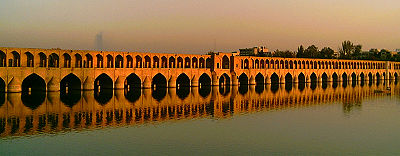
Etymology
The Oxford English Dictionary traces the origin of the word bridge to an Old English word brycg, of the same meaning, derived from a hypothetical Proto-Germanic root brugjō. There are cognates in other Germanic languages (for instance Brücke in German, brug in Dutch, brúgv in Faroese or bro in Danish, Norwegian and Swedish).
History
The first bridges were spans made of wooden logs or planks and eventually stones, using a simple support and crossbeam arrangement. Most of these early bridges were very poorly built and could rarely support heavy weights. It was this inadequacy which led to the development of better bridges. The arch was first used by the Roman Empire for bridges and aqueducts, some of which still stand today. These arch based bridges could stand in conditions that would previously have swept any bridge away.
An example is the Alcántara Bridge, built over the river Tagus, near Portugal. Most earlier bridges would have been swept away by the strong current. The Romans also used cement, which reduced the variation of strength found in natural stone. One type of cement, called pozzolana, consisted of water, lime, sand, and volcanic rock. Brick and mortar bridges were built after the Roman era, as the technology for cement was lost then later rediscovered.
Although large Chinese bridges existed in wooden construction since the ancient Warring States, the oldest surviving stone bridge in China is the Zhaozhou Bridge, built from 595 to 605 C.E. during the Sui Dynasty. This bridge is also historically significant as it is the world's oldest open-spandrel stone segmental arch bridge. European segmental arch bridges date back to at least the Alconétar Bridge (approximately second century C.E.), while the enormous Roman era Trajan's Bridge (105 C.E.) featured open-spandrel segmental arches in wooden construction.
Rope bridges, a simple type of suspension bridge, were used by the Inca civilization in the Andes mountains of South America, just prior to European colonization in the 1500s.
During the eighteenth century, there were many innovations in the design of timber bridges by Hans Ulrich, Johannes Grubenmann, and others. The first engineering book on building bridges was written by Hubert Gautier in 1716.
With the Industrial Revolution in the nineteenth century, truss systems of wrought iron were developed for larger bridges, but iron did not have the tensile strength to support large loads. With the advent of steel, which has a high tensile strength, much larger bridges were built, many using the ideas of Gustave Eiffel.
Types
There are six main types of bridges: beam bridges, cantilever bridges, arch bridges, suspension bridges, cable-stayed bridges, and truss bridges.
By use
A bridge is designed for trains, pedestrian or road traffic, a pipeline or waterway for water transport or barge traffic. In some cases there may be restrictions in use. For example, it may be a bridge carrying a highway and forbidden for pedestrians and bicycles, or a pedestrian bridge, possibly also for bicycles. A Road-rail bridge carries both road and rail traffic.
The area underneath several bridges have become makeshift shelters and homes to homeless people.
The undersides of bridges all around the world are spots of prevalent graffiti.
An aqueduct is a bridge that carries water, resembling a viaduct, which is a bridge that connects points of equal height.
Decorative or ceremonial
To create a beautiful image, some bridges are built much taller than necessary. This type, often found in east-Asian style gardens, is called a Moon bridge, evoking a rising full moon.
Other garden bridges may cross only a dry bed of stream washed pebbles, intended only to convey an impression of a stream.
Often in palaces a bridge will be built over an artificial waterway as symbolic of a passage to an important place or state of mind. A set of five bridges cross a sinuous waterway in an important courtyard of the Forbidden City in Beijing, the People's Republic of China. The central bridge was reserved exclusively for the use of the Emperor, Empress, and their attendants.
Distribution of forces in bridge structures
Bridges may be classified by how the four forces of tension, compression, bending and shear are distributed through their structure. Most bridges will employ all of the principal forces to some degree, but only a few will predominate. The separation of forces may be quite clear. In a suspension or cable-stayed span, the elements in tension are distinct in shape and placement. In other cases the forces may be distributed among a large number of members, as in a truss, or not clearly discernible to a casual observer as in a box beam.
Efficiency
A bridge's structural efficiency may be considered to be the ratio of load carried to bridge weight, given a specific set of material types. In one common challenge, students are divided into groups and given a quantity of wood sticks, a distance to span, and glue, and then asked to construct a bridge that will be tested to destruction by the progressive addition of load at the center of the span. The bridge taking the greatest load is by this test the most structurally efficient. A more refined measure for this exercise is to weigh the completed bridge rather than measure against a fixed quantity of materials provided and determine the multiple of this weight that the bridge can carry, a test that emphasizes economy of materials and efficient glue joints.
A bridge's economic efficiency will be site and traffic dependent, the ratio of savings by having a bridge (instead of, for example, a ferry, or a longer road route) compared to its cost. The lifetime cost is composed of materials, labor, machinery, engineering, cost of money, insurance, maintenance, refurbishment, and ultimately, demolition and associated disposal, recycling, and replacement, less the value of scrap and reuse of components. Bridges employing only compression are relatively inefficient structurally, but may be highly cost efficient where suitable materials are available near the site and the cost of labor is low. For medium spans, trusses or box beams are usually most economical, while in some cases, the appearance of the bridge may be more important than its cost efficiency. The longest spans usually require suspension bridges.
Special installations
Some bridges carry special installations such as the tower of Nový Most bridge in Bratislava which carries a restaurant. On other suspension bridge towers transmission antennas are installed.
A bridge can carry overhead power lines as the Storstrøm Bridge.
Types of bridges
- BNSFBridgeClip.jpg
Lift bridge
Related topics
- Guilford vermont covered bridge 20040820.jpg
Covered bridge - Guilford vermont bridge covered bridge interior 20040820.jpg
Lattice truss
(Town's lattice truss)
See also
ReferencesISBN links support NWE through referral fees
- Whitney, Charles S. 2003. Bridges of the World: Their Design and Construction. Mineola, NY: Dover Publications. ISBN 0486429954.
- Bernhard Graf, Bern. 2005. Bridges That Changed the World. New York, NY: Prestel Publishing. ISBN 379133400X.
- Brown, David J. 2005. Bridges: Three Thousand Years of Defying Nature. Ontario, Canada: Firefly Books. ISBN 1554070996
External links
- Interactive Google Based Map of US Bridges - USbridgemap.com. Retrieved August 18, 2007.
- Structurae - International Database and Gallery of Structures with over 10 000 Bridges. Retrieved August 18, 2007.
- American Society of Landscape Architects Designing Bridges in Landscape Architecture - The Bridge Architect. Retrieved August 18, 2007.
- American Society of Civil Engineers History and Heritage of Civil Engineering - Bridges. Retrieved August 18, 2007.
- Bridge Building — Art and Science Comprehensive explanations about bridges. Retrieved August 18, 2007.
- Bridge Basics A guide to bridge terminology and styles. Retrieved August 18, 2007.
- Bridge disasters. Retrieved August 18, 2007.
- A dictionary of bridge terms. Retrieved August 18, 2007.
- Digital Bridge Library at Lehigh University. Retrieved August 18, 2007.
- Bridges and Tunnels of Allegheny County and Pittsburgh, PA Details of over 2,000 bridges of 8 feet span or greater. Bridge engineers hold their conventions in Pittsburgh. Retrieved August 18, 2007.
- Federal Highway Administration Bridge Technology. Retrieved August 18, 2007.
- Video on how bridges are made (Grade school level educational film by National Association of Manufactures.) Caution: Other links on this page may lead to politically biased material. Retrieved August 18, 2007.
- Federal Highway Administration - The Landscape Architect's Role as Designer of Roads and Bridges. Retrieved August 18, 2007.
- Photos and history about more than 300 bridges. Retrieved August 18, 2007.
- Atlanta, Georgia's Worst Bridges. Retrieved August 18, 2007.
Credits
New World Encyclopedia writers and editors rewrote and completed the Wikipedia article in accordance with New World Encyclopedia standards. This article abides by terms of the Creative Commons CC-by-sa 3.0 License (CC-by-sa), which may be used and disseminated with proper attribution. Credit is due under the terms of this license that can reference both the New World Encyclopedia contributors and the selfless volunteer contributors of the Wikimedia Foundation. To cite this article click here for a list of acceptable citing formats.The history of earlier contributions by wikipedians is accessible to researchers here:
The history of this article since it was imported to New World Encyclopedia:
Note: Some restrictions may apply to use of individual images which are separately licensed.
